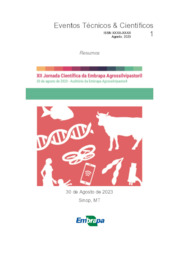Automated body score assessment for dairy cows using depth image processing.
Automated body score assessment for dairy cows using depth image processing.
Autoria: BENICIO, L. M.; XAVIER, D. B.; LIMA, I. B. G. de; CONDOTTA, I. C. F. da S.; LOPES, L. B.
Resumo: Abstract: The body condition score (BCS) is the most helpful system available to dairy farmers to assess the nutritional status of cows, as it indicates the body fat levels of the animals. Body condition assessment of dairy cows can be used as a management tool for feeding, reproduction, health, and longevity of the herd. However, observers' assessment of body condition can be considered a subjective method, which may contain biases and disagreements between assessors, making the observational method less accurate. Thus, more objective and automatic systems using image processing can be considered alternatives for obtaining the body score. Imaging allows for obtaining the score of more than one animal at the same time, besides being possible to obtain such information remotely, being considered a non-invasive and non-stressful system for the herd, being possible to adopt such a tool in real-time. Therefore, the present work aimed to develop an automatic system for obtaining the body score of dairy cows through depth images. An Intel RealSense depth sensor was installed above the corridor of the passage of the animals to the electronic scale to collect images of forty animals. Then, an image-processing algorithm and extraction of animal surface area, projected volume, average animal height, and minimum and maximum body lengths were developed. Subsequently, the extracted data were correlated with the body score, obtained manually by observers during image collection, through a machine learning model. In that model, the body dimensions were used as the input source and the body score as the output. The score observed ranged from 2 to 4.5. The preliminary results of this study revealed an R2 of 0.75 and an average error of 4%. This R2 value can be explained by the small number of images used for each score. However, it should be emphasized that the initial model presented a relatively low error compared to the manual classification. Thus, it is possible to confirm the tool's potential to correctly and automatically evaluate the body score of the animals, especially after the insertion of the next steps for the improvement and performance of the model and inserting a more significant number of animals into the analysis.
Ano de publicação: 2023
Tipo de publicação: Resumo em anais e proceedings
Unidade: Embrapa Agrossilvipastoril
Palavras-chave: Body condition, Image processors, Machine learning
Observações
1 - Por padrão são exibidas publicações dos últimos 20 anos. Para encontrar publicações mais antigas, configure o filtro ano de publicação, colocando o ano a partir do qual você deseja encontrar publicações. O filtro está na coluna da esquerda na busca acima.
2 - Para ler algumas publicações da Embrapa (apenas as que estão em formato ePub), é necessário ter, no celular ou computador, um desses softwares gratuitos. Sistemas Android: Google Play Livros; IOS: iBooks; Windows e Linux: software Calibre.
Acesse outras publicações
Acesse a Base de Dados da Pesquisa Agropecuária (BDPA) para consultar o acervo completo das bibliotecas da Embrapa.

